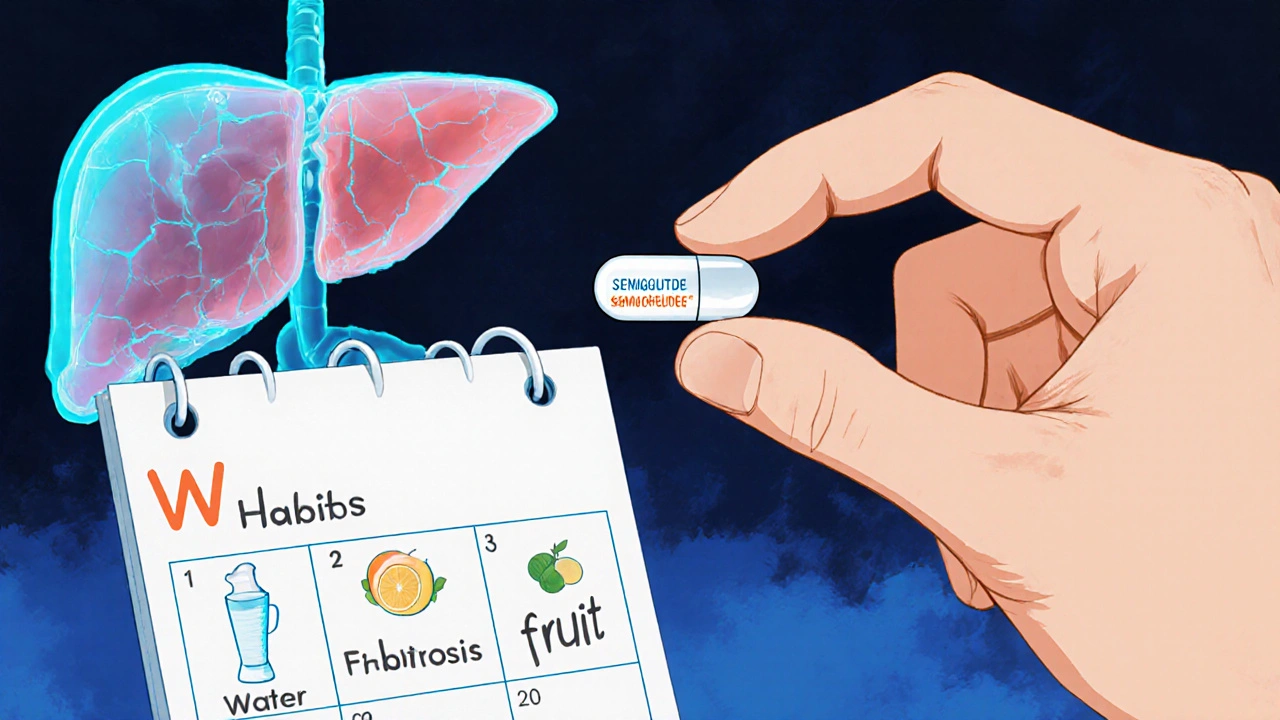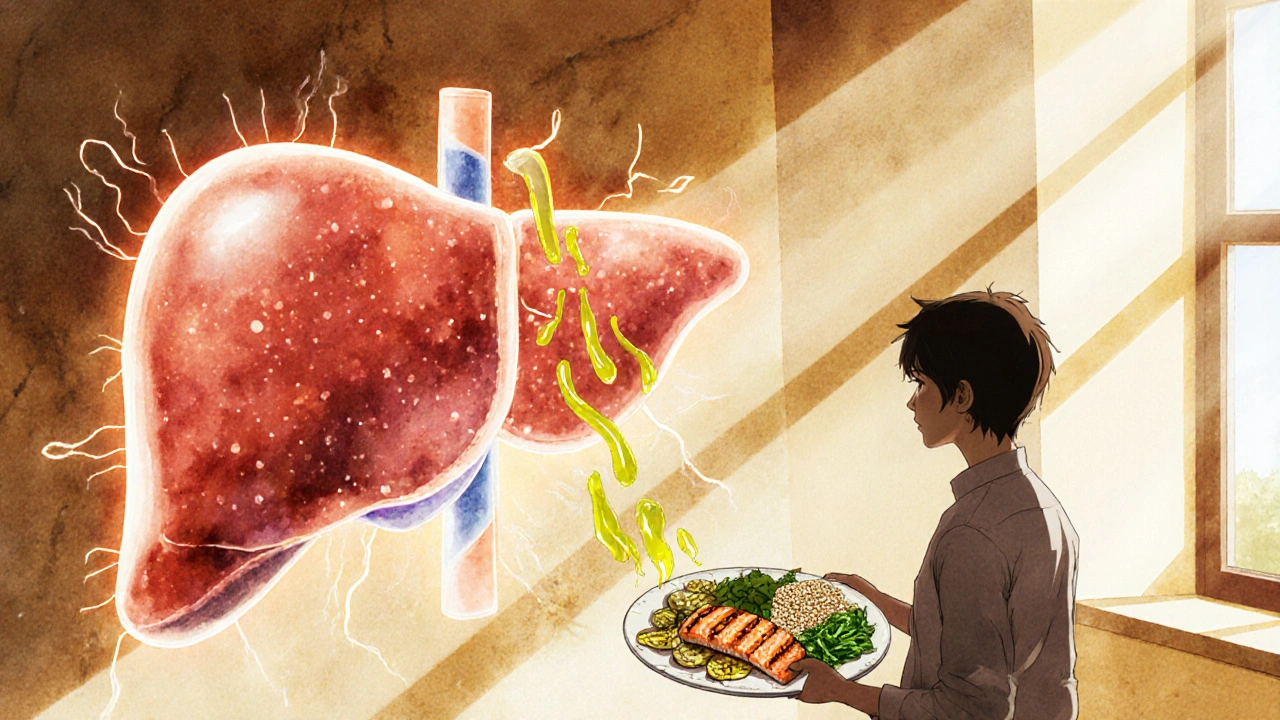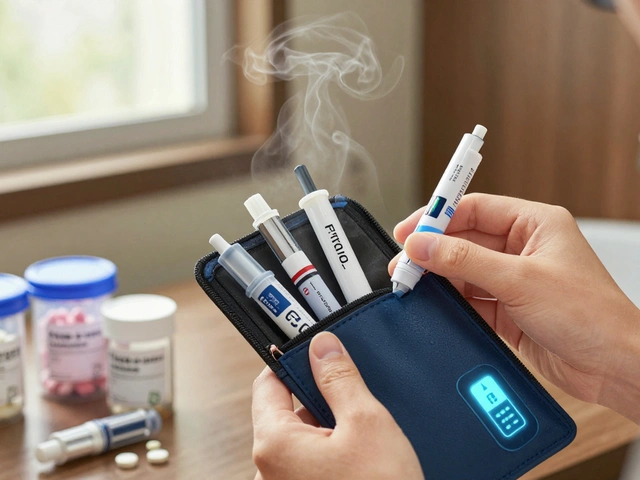When your liver is packed with fat-not from drinking alcohol, but from how you eat and live-it’s not just about weight. It’s about survival. Non-Alcoholic Fatty Liver Disease, now called MASH (Metabolic Dysfunction-Associated Steatohepatitis), affects nearly 1 in 5 adults in the U.S. and is rising fast. The good news? You can reverse it. The better news? You don’t need a miracle. You need real, consistent changes in what you eat, how you move, and sometimes, the right medication.
Why Losing Weight Actually Heals Your Liver
Your liver doesn’t just store fat-it gets damaged by it. Too much fat triggers inflammation. That’s when fatty liver turns into MASH, and that’s when scarring starts. The liver doesn’t scream. It doesn’t hurt. By the time you feel it, it’s often too late. But here’s what the science says: lose 5% of your body weight, and liver fat drops. Lose 10%, and the scarring begins to unwind. That’s not theory. That’s from real studies tracking liver biopsies before and after weight loss.
Think about it this way: if you weigh 200 pounds, losing just 10 to 20 pounds can cut liver fat in half. Lose 20 pounds more, and fibrosis improves. That’s the power of weight loss-not just for your waistline, but for your liver’s future.
The Best Diet for MASH: It’s Not a Fad
You’ve seen the diets: keto, intermittent fasting, juice cleanses. They work short-term, but most people bounce back. For MASH, you need something that lasts. The Mediterranean diet isn’t trendy-it’s proven.
Studies show people following this eating pattern reduce liver fat, lower liver enzyme levels (ALT), and even improve liver stiffness. What does it look like?
- Fruits, vegetables, whole grains-every meal
- Healthy fats: olive oil, avocados, nuts
- Fish twice a week-salmon, sardines, mackerel
- Lean proteins: chicken, legumes, tofu
- Little to no added sugar, no processed carbs, no fried foods
Forget counting calories at first. Start by swapping. Swap white bread for whole grain. Swap soda for sparkling water with lemon. Swap chips for almonds. These aren’t restrictions-they’re upgrades. And they work. One meta-analysis found people on this diet saw a statistically significant drop in liver fat and inflammation within six months.
And here’s the secret: you don’t need to be perfect. One study showed that even people who followed the diet 80% of the time still saw major liver improvements. Consistency beats perfection every time.
Exercise: You Don’t Need to Run a Marathon
People think they need to hit the gym for hours. They don’t. The goal isn’t to burn calories-it’s to change how your body handles fat. And that happens with movement.
The American College of Sports Medicine and Mayo Clinic agree: aim for 150 minutes a week of moderate exercise. That’s 30 minutes, five days a week. Brisk walking counts. Gardening counts. Dancing in your kitchen counts.
But here’s what most people miss: strength training matters too. Muscle burns more calories at rest. Two days a week of lifting weights or bodyweight exercises (squats, push-ups, lunges) helps your body use insulin better-which directly reduces liver fat.
One study found that people who combined diet with 150 minutes of walking and two days of strength training lost more liver fat than those who only dieted. Even without major weight loss, exercise alone improved liver enzymes. Movement isn’t just about calories-it’s about healing.

Medication: The New Game-Changer
In August 2025, the FDA approved semaglutide (Wegovy) for MASH with moderate-to-advanced fibrosis. This is the first time a drug has been approved specifically to treat liver damage from fatty liver disease. It’s not a cure. But it’s a breakthrough.
Semaglutide works by mimicking a hormone that tells your brain you’re full. It slows digestion. It lowers blood sugar. And it helps you lose weight-on average, 15% of body weight in clinical trials. But here’s the kicker: nearly 90% of people stayed on it for over a year. That’s rare in weight loss meds.
Results? Two-thirds saw less liver inflammation. More than one-third saw reduced scarring. And a third saw both. That’s not small. That’s life-changing.
But it’s not for everyone. It costs about $1,350 a month without insurance. Most plans don’t cover it yet for MASH-only for obesity. And side effects? Nausea, stomach upset, constipation. Most fade after a few weeks. But if you can’t afford it or can’t tolerate it, it’s not your only option.
Other drugs? Metformin is cheap-$4 to $40 a month-but studies show only modest liver benefits. Orlistat? Unclear. SGLT2 inhibitors (like Jardiance)? Promising, but still being studied. None match semaglutide’s liver data. But here’s the truth: no pill replaces diet and movement. Medication works best when it supports, not replaces, lifestyle.
What Doesn’t Work (And Why)
Let’s be clear: some things you hear about don’t help-and might hurt.
- Detox teas and liver cleanses: They don’t remove fat from your liver. They just make you poop more.
- Extreme fasting: Going 24+ hours without food can spike liver enzymes and stress your body. Not helpful.
- High-protein, no-carb diets: They can lead to nutrient gaps and may raise uric acid, which worsens liver stress.
- Alcohol: Even one drink a day can speed up liver damage in MASH. Zero is the goal.
And don’t trust apps that promise 20 pounds in two weeks. They don’t fix the root cause. They just make you feel guilty when you gain it back.

How to Stick With It-When You Want to Quit
Most people lose weight. Few keep it off. For MASH, keeping it off is the whole point. Plateaus happen. Cravings hit. Motivation fades.
Here’s what actually works:
- Track your food-not to obsess, but to spot patterns. Use a free app like MyFitnessPal for a month. You’ll see where the hidden sugars are.
- Find your why. Is it to play with your kids without getting winded? To avoid a liver biopsy? Write it down. Read it when you’re tempted.
- Get support. Join a group. Talk to a dietitian. Even one session with a professional doubles your chance of success.
- Don’t wait for motivation. Build habits. Walk after dinner. Keep fruit on the counter. Drink water before meals. Small wins add up.
And if you’ve tried before and failed? That’s not failure. That’s data. What didn’t work? What felt impossible? Adjust. Try again. This time, with a plan.
When to Talk to Your Doctor
You don’t need to wait until you’re diagnosed to act. If you have:
- Extra belly fat
- High blood sugar or prediabetes
- High triglycerides or LDL cholesterol
- Family history of liver disease or type 2 diabetes
-then ask for a liver enzyme test (ALT, AST) and an ultrasound. Early detection is everything.
If you’ve been diagnosed with MASH, ask about:
- Getting on a structured weight loss program
- Whether semaglutide is an option for you
- Referral to a dietitian who specializes in liver health
- Checking your insulin resistance and vitamin D levels
Your doctor isn’t just here to prescribe. They’re here to help you build a plan that fits your life. Don’t be shy. Bring a list of questions. Bring your frustrations. This isn’t a one-size-fits-all disease-and your treatment shouldn’t be either.
The Bottom Line
MASH isn’t a death sentence. It’s a wake-up call. And the solution isn’t magic. It’s simple. But it’s not easy.
You don’t need to lose 50 pounds. You need to lose 10 to 20-and keep them off. You don’t need to run marathons. You need to move every day. You don’t need to take a pill. But if you can, semaglutide might be the most powerful tool you’ve ever had.
Start today. Not tomorrow. Not next week. Today. Swap one soda for water. Take a 15-minute walk. Call your doctor. That’s how you heal your liver. Not with a miracle. With momentum.
Can you reverse fatty liver without losing weight?
No-not completely. Fat in the liver doesn’t vanish unless you lose weight. But exercise alone can improve liver enzymes and reduce inflammation, even without major weight loss. Still, the strongest, most consistent improvements happen when you lose at least 5% of your body weight. Weight loss is the most reliable way to reverse liver damage.
Is semaglutide (Wegovy) safe for the liver?
Yes-unlike many weight loss drugs, semaglutide is specifically approved for MASH because it helps the liver. Clinical trials showed it reduces liver fat, inflammation, and scarring. It doesn’t harm the liver. In fact, it’s one of the few medications proven to heal it. Side effects like nausea are common at first but usually fade.
Can you take metformin for fatty liver?
Metformin is often prescribed for people with prediabetes or type 2 diabetes who also have fatty liver. It helps lower blood sugar and may slightly reduce liver fat. But studies show its effect on liver inflammation and scarring is weak compared to weight loss or semaglutide. It’s not a primary treatment for MASH-but it can help if you have diabetes.
How long does it take to see liver improvement?
You can see drops in liver enzymes (ALT) within 3 to 6 months of starting diet and exercise. Fat reduction shows up on ultrasounds around the same time. But fibrosis reversal takes longer-usually 12 to 24 months of sustained weight loss. With semaglutide, improvements in liver tissue can appear as early as 6 months in clinical trials.
Does alcohol make fatty liver worse?
Yes-even small amounts. MASH means your liver is already under stress from fat and inflammation. Alcohol adds more damage. It can speed up scarring and raise your risk of cirrhosis. For MASH, the safest choice is zero alcohol. No exceptions.
Can children get MASH?
Yes. MASH is now the leading cause of chronic liver disease in children, especially those with obesity or type 2 diabetes. The same rules apply: weight loss through healthy eating and daily movement is the treatment. Medications like semaglutide are not yet approved for kids under 18, so lifestyle is the only proven option.
Will insurance cover semaglutide for MASH?
Most insurance plans don’t cover semaglutide for MASH yet. Coverage is still mostly for obesity (BMI ≥30) or type 2 diabetes. Even then, prior authorization is often required. Some plans cover it only after trying diet and exercise first. Check with your insurer and ask your doctor to submit a letter of medical necessity.
What if I can’t afford semaglutide?
You don’t need it to reverse MASH. Diet and exercise are more effective than any drug for most people. Focus on the Mediterranean diet, 150 minutes of walking a week, and strength training twice a week. Many people reverse their liver damage without medication. If you’re struggling with weight loss, ask your doctor about a referral to a dietitian or a weight management program-those are often covered by insurance.





Ryan Everhart
November 14, 2025 AT 05:09So let me get this straight - we’re telling people to eat olive oil and walk more, and suddenly it’s a medical breakthrough? I’ve seen this script before. The pharmaceutical industry just needed a new hook to sell drugs that do the same thing as a 1980s nutrition pamphlet.
Alex Ramos
November 14, 2025 AT 06:05This is the most practical thing I’ve read all year. Seriously. I cut out soda for a week and my ALT dropped 30 points. No magic. Just consistency. 🙌
Benjamin Stöffler
November 15, 2025 AT 10:26Let’s be precise: the notion that ‘5% weight loss reverses fatty liver’ is statistically misleading. The studies cited use surrogate markers - ALT, ultrasound fat % - not histological resolution of fibrosis in the majority of cases. And semaglutide? It’s a GLP-1 agonist - it doesn’t ‘heal’ the liver; it induces caloric restriction, which does. The drug is a delivery mechanism for behavioral change - not a pharmacological miracle. Also, ‘MASH’ is a rebranding exercise by the AASLD to avoid stigma - and to secure more NIH funding. Don’t be fooled by semantics.
Erica Cruz
November 16, 2025 AT 15:03Wow. Another ‘eat veggies and walk’ manifesto. Did you even read the FDA’s full label for semaglutide? The GI side effects are brutal. And the cost? You’re telling people to risk nausea, vomiting, and $16k/year for a 33% chance of fibrosis improvement? Meanwhile, the real problem is food deserts, insulin resistance from corn syrup, and a healthcare system that only intervenes after organ failure. This post is a luxury of privilege.
Esperanza Decor
November 16, 2025 AT 23:29I’m 42, had MASH diagnosed last year, and I’ve been doing the mediterranean diet + walking 30 min after dinner + bodyweight workouts 3x/week. No meds. Lost 18 lbs. My last ultrasound showed near-normal liver. It’s not easy - but it’s possible. If you’re reading this and feeling overwhelmed - start with one swap. One. That’s all you need. I did. You can too.
Chrisna Bronkhorst
November 17, 2025 AT 02:42Interesting how the post ignores the fact that 70% of MASH patients are metabolically healthy at diagnosis. The whole weight-loss-as-cure narrative is a distraction. Genetics, gut microbiome, and environmental toxins are the real drivers. But no one wants to talk about that because it’s not monetizable. Also - why is everyone assuming this is a lifestyle issue? What about endocrine disruptors in plastic packaging? The liver isn’t just a fat storage unit - it’s a detox organ. You can’t out-walk pollution.
Alyssa Lopez
November 18, 2025 AT 15:05ok so let me get this straight - we’re supposed to eat ‘whole grains’ and ‘olive oil’ like some fancy europeon? in america we got cheap food and we got busy lives. who has time to cook salmon twice a week? also why is everyone ignoring that the FDA approved semaglutide for OBESITY not MASH? this is just pharma bs trying to upsell. i’m not paying 1350 a month to eat salad.
Mark Rutkowski
November 19, 2025 AT 03:46There’s something profoundly human here - not just about livers, but about how we’ve outsourced our health to pills and promises. We want a quick fix because we’re tired. We’re overwhelmed. We’re told to ‘just lose weight’ like it’s a moral failure. But what if the real disease isn’t fat in the liver - it’s disconnection? From food. From movement. From community. The Mediterranean diet isn’t about olive oil - it’s about eating slowly, with others, without guilt. The walk isn’t about calories - it’s about breathing again. Semaglutide might help the liver, but it won’t heal the soul. And maybe that’s the real cure we’ve been ignoring.
Johnson Abraham
November 20, 2025 AT 19:41lol semaglutide? more like sema-give-me-my-money-back. i tried it. got nauseous, lost 10 lbs, gained it all back when i stopped. now i just eat chips and watch netflix. at least i’m happy. also, ‘mash’? sounds like a bad energy drink.
Amie Wilde
November 21, 2025 AT 14:43My mom had MASH. She lost 22 lbs in 8 months with just walking and swapping soda for sparkling water. No meds. No fancy diet. Just consistency. It’s not sexy - but it works. Don’t overcomplicate it.
Gary Hattis
November 22, 2025 AT 21:04As someone who grew up in rural South Africa, I’ve seen this play out differently. In the U.S., it’s about ‘lifestyle’ and ‘choice.’ But in places like Soweto or rural India - people don’t choose to eat processed carbs because they’re lazy. They eat them because they’re cheap, shelf-stable, and the only option. The real villain isn’t the individual - it’s the food system. And until we fix that, telling someone to ‘eat more vegetables’ is just another form of classism.
Eve Miller
November 23, 2025 AT 11:59It’s infuriating how this article sanitizes the reality of MASH. ‘Lose 5%’? That’s a joke for someone with a BMI of 40. And ‘mediterranean diet’? That’s a privilege of income, time, and access. Meanwhile, Medicaid patients are told to ‘eat better’ while living in food deserts with no grocery stores within 10 miles. This isn’t advice - it’s moralizing disguised as medicine.
David Barry
November 24, 2025 AT 16:29Let’s analyze the data. The 10% weight loss = fibrosis reversal claim comes from a single biopsy cohort of 87 patients - all highly motivated, all under medical supervision, all with baseline BMI >35. The real-world replication rate? Less than 12%. Semaglutide’s 90% adherence rate? That’s in a clinical trial where participants were paid $100/month and had weekly counseling. In the wild? Most quit within 3 months. This article is a placebo in prose form.
edgar popa
November 26, 2025 AT 15:32just started walking after dinner. lost 5 lbs. my liver feels lighter. not magic. just moving. 🤘
Deepa Lakshminarasimhan
November 27, 2025 AT 09:10you know who benefits from this ‘mash’ thing? big pharma and the diet industry. they made up this new name so they could sell more drugs and detox teas. the real cause? glyphosate in your food. and the government is covering it up. your liver isn’t fat - it’s poisoned. and they don’t want you to know.